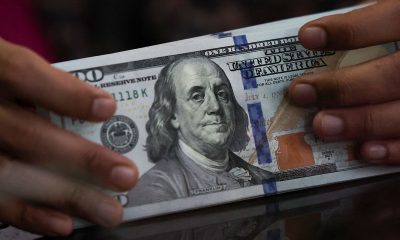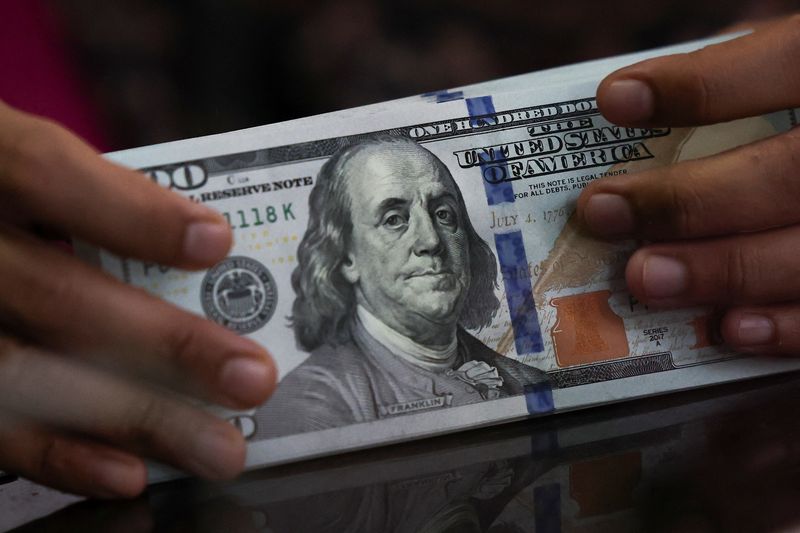Forex
Sterling slips as BoE holds rates, Swiss franc tumbles after surprise SNB cut


© Reuters. FILE PHOTO: Woman holds U.S. dollar banknotes in this illustration taken May 30, 2022. REUTERS/Dado Ruvic/Illustration/File Photo
2/2
By Joice Alves
LONDON (Reuters) -Sterling fell after the Bank of England (BoE) on Thursday kept its benchmark interest rate on hold as expected, while the Swiss franc fell to a multi-month low after the Swiss National Bank (SNB) surprised markets by cutting interest rates.
The BoE’s interest rate-setters voted 8-1 to keep borrowing costs at their 16-year high of 5.25% as the two officials who had previously called for higher rates changed their stance.
Governor Andrew Bailey said there had been “further encouraging signs that inflation is coming down” but he also said the BoE needed more certainty that price pressures in the economy were fully under control.
Sterling was last 0.3% lower on the day at $1.2742. Against the euro, it fell 0.23% to 85.62 pence, after hitting an almost three-week low.
“None of the nine MPC (Monetary Policy Committee) members opted for a hike this time around, compared with two last time. Markets took the news as dovish, with Gilts rallying and the pound weaker,” said Matthew Landon, Global Market Strategist at J.P. Morgan Private Bank.
“Still, the BoE looks more likely to be in the ‘late cutter’ camp. Even with recent progress that we have seen on price pressures, the UK still looks to be a couple of steps behind the rest of the world on their inflation battle.”
The BoE’s decision came a day after data showed inflation fell to its lowest level in almost two-and-a-half years – even if it remains higher than the bank wants.
Elsewhere, the Swiss franc fell sharply against the dollar and sank to its weakest point since last July against the euro, after the Swiss National Bank (SNB) unexpectedly cut rates.
The euro climbed against the Swiss franc to 0.978, the most since July 2023. It was last up 0.75% to 0.975. Against the dollar, the Swiss franc fell 0.84% to 0.8943, after briefly hitting its lowest since November.
The SNB cut its main interest rate by 25 basis points to 1.50%, a surprise move which made it the first major central bank to dial back tighter monetary policy aimed at tackling inflation.
A majority of analysts polled by Reuters had expected the SNB to keep rates on hold. It was the bank’s first rate cut in nine years.
“It’s the first central bank in the developed world to ease, so that shows the direction where the others are going,” said Jan Von Gerich, chief analyst at Nordea.
“The SNB was always the first likely mover, so this shouldn’t have an impact on what the others will do… But from the markets’ point of view, this does open the door to what could happen elsewhere,” he added.
The Norwegian crown steadied against the dollar, after Norges Bank kept its rate unchanged, as expected.
The crown was 0.1% higher to 10.5480.
The Turkish lira rallied 0.8% to 32.13 against the dollar after weeks of steady declines, as Turkey’s central bank unexpectedly raised its key interest rate by 500 basis points to 50% on Thursday, citing a deteriorating inflation outlook and pledging to keep a tight stance until there is a significant and sustained drop in the trend.
The yen steadied against a strengthening dollar as it drew some support from expectations of further rate hikes from the Bank of Japan later this year and some jawboning efforts from Japanese government officials.
The yen was last 0.1% higher on the day at 151.11, after rallying in Asian trading hours and reversing some of its heavy losses in the wake of this week’s BOJ policy shift.
The rose 0.28% to 103.51 after falling almost 0.5% on Wednesday.
In a week packed with central banks meetings, the Federal Reserve on Wednesday maintained its projections for interest rate cuts for the year in the face of upside surprises on inflation, and did not strike a more hawkish tone as some investors had feared.

 Forex3 years ago
Forex3 years agoForex Today: the dollar is gaining strength amid gloomy sentiment at the start of the Fed’s week

 Forex3 years ago
Forex3 years agoUnbiased review of Pocket Option broker

 Forex3 years ago
Forex3 years agoDollar to pound sterling exchange rate today: Pound plummeted to its lowest since 1985

 Forex3 years ago
Forex3 years agoHow is the Australian dollar doing today?

 Cryptocurrency3 years ago
Cryptocurrency3 years agoWhat happened in the crypto market – current events today

 World3 years ago
World3 years agoWhy are modern video games an art form?

 Commodities3 years ago
Commodities3 years agoCopper continues to fall in price on expectations of lower demand in China

 Economy3 years ago
Economy3 years agoCrude oil tankers double in price due to EU anti-Russian sanctions





























